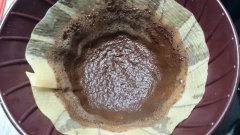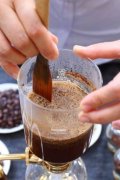Hand coffee stirring method Daquan explains how to stir hand coffee?

Professional coffee knowledge exchange more coffee bean information please follow the coffee workshop (Wechat official account cafe_style)
Comparison of kono filter cup hand-brewing methods: Ben flow VS Kanazawa flow KONO drip type and stirring type cooking
Drip coffee is really great! You can watch the water flow stay gracefully, while the good coffee is like a crystal liquid, and the best thing is that we can all brew it ourselves at home.
But it looks great, but it's not as simple as it seems. Many people say that a cup of smooth and stable quality coffee needs to be stirred. Then what is agitation? What do the experts say about stir-filtered coffee? And most importantly, does it really taste better after stirring? Let's see.
Use Hario V60 to brew
What is agitation?
Let's start with the basics, we all know that there are two procedures in the filtration process: first, soaking the coffee powder with a small amount of hot water to achieve the effect of steaming in about half a minute; second, injecting the remaining water into the coffee powder so that the coffee can slowly drip into the receiving container.
But there is also agitation (also known as turbulence) in the process, just like your brother and sister showing up next to you when you are busy, but not so negative. Oh, and you are actually playing the role of brother and sister.
To put it simply, stirring in the cooking process is a mild interference. There are many ways of stirring, each of which has its own reason. Before we see how to stir, let's see what you want to achieve.
Steaming when coffee brewing is cooked with Kalita Wave
To make a long story short-what can be achieved by stirring?
We are all trying to bring out the good taste of the coffee, which means that we need to achieve a consistent extraction, and if the extraction rate of the powder in different blocks is different, you will not be able to manipulate or replicate the flavor in the cup. As a result, your coffee will be a mixture of underextracted (sour) and overextracted (bitter) elements, as well as well-extracted elements: sweet and well-balanced coffee.
Make hand-made coffee
A common issue in hand-brewed or espresso coffee is the channel effect. Water always flows to places with less resistance, so if the coffee powder is not stacked or soaked evenly, the water will create a channel in the coffee powder. and this will make the coffee near the channel extract to a greater extent.
The channel effect can be caused by too fast or unstable water injection, for example, this leaves a high and dry coffee powder wall on the filter paper, which cannot be extracted. Some people also use drip water injection (using a small amount of water instead of long water injection many times) to avoid the emergence of this kind of powder wall.
In other words, stirring will disperse the coffee powder and ensure the uniformity of the extraction, which is not the only reason for maintaining a consistent extraction. If you want the coffee to taste the same every day, try standardizing your brewing parameters, including: powder quantity, water temperature, brewing filter, water injection path and speed, water quality, grinding thickness and brewing time.
Grind coffee powder to be brewed in coffee brewingKalita Wave filter cup
How to stir hand brew / drip coffee
There are several ways of stirring, the most common of which is stirring, which is recommended by some coffee experts, such as Barista Hustle's Matt Perger and Scott Rao, a well-known coffee trainer and author of famous coffee books. You can stir the coffee powder directly after steaming, or at the beginning of steaming, or during cooking in the back section.
You may also have heard of spoiler, which means that at the end of the injection, pour the water into the edge of the filter cup and flush the top coffee powder into the coffee liquid from the edge.
Agitation can also take several forms, such as drips of water, side swirls, controlling the flow rate and amount of water, and so on.
Coffee brewing
The force of water injection can stir the coffee powder.
What techniques do experts use?
Earlier we mentioned Matt Perger and Scott Rao when we talked about the importance of stirring. Let's take a look at their methods here. When Matt Perger won the 2012 World Cooking Competition a few years ago, he shared a film about the cooking of V60 filter cups. You can break down his movements, notice that he stirs vigorously after steaming, then control the direction of the hand (the expanding concentric circle), use these forces to avoid the powder wall, cook rhythmically, and pull up and gently shake the filter cup before the end. make the powder bed horizontal.
He can also be seen in the film using Rao Spin, which takes its name from Scott Rao, which allows the water to rotate in a spiral during cooking, thus allowing the water to drop more evenly.
Even though Rao wasn't the inventor of the technology, the technology was developed from his work, and he supports it. According to Rao, "this technology minimizes the channel effect at the end of cooking and creates a flat powder bed at each time. It's so great that I even wish I invented it."
You can also create a Rao Spin by gently shaking the filter cup, which is shown in the following seven-second video shot by Rao.
So how do we apply it?
You can try all of the above, whether you are a barista, a coffee lover or just a beginner, stir while brewing, try not to stir in the next round, and then test the differences yourself, or share them with your friends. and show it to your guests.
Find out the differences, taste the subtle changes in the coffee, and change the grinding thickness and brewing methods, and then find the best way to copy so that the brewing results can be consistent.
The best thing about the third wave of coffee is the experiment, in which you do some stirring experiments to see if this method is suitable for you.
.
Important Notice :
前街咖啡 FrontStreet Coffee has moved to new addredd:
FrontStreet Coffee Address: 315,Donghua East Road,GuangZhou
Tel:020 38364473
- Prev

The common hand-brewing method of stirring hand-brewed coffee matters needing attention
Professional coffee knowledge exchange more coffee bean information please follow the coffee workshop (Wechat official account cafe_style) kono filter cup hand brewing method comparison: Ben flow VS Kanazawa flow KONO drip type, stirring type (3: stirring method) this technique was used by Matt Perger in 2012 and won the championship of that year's World Brewers cup since it began to roll up a wave of mixing.
- Next

How does the force of stirring, stirring and impact affect the extraction rate when brewing coffee?
Professional coffee knowledge exchange more coffee bean information please follow the coffee workshop (Wechat official account cafe_style) kono filter cup hand flushing method comparison: Ben flow VS Kanazawa flow KONO drip brewing, stirring type brewing, whether it is practice hand brewing or siphon pot, when brewing coffee, pay attention to the coffee powder and water in the process of operation, the water in the impact road is strong
Related
- Beginners will see the "Coffee pull flower" guide!
- What is the difference between ice blog purified milk and ordinary milk coffee?
- Why is the Philippines the largest producer of crops in Liberia?
- For coffee extraction, should the fine powder be retained?
- How does extracted espresso fill pressed powder? How much strength does it take to press the powder?
- How to make jasmine cold extract coffee? Is the jasmine + latte good?
- Will this little toy really make the coffee taste better? How does Lily Drip affect coffee extraction?
- Will the action of slapping the filter cup also affect coffee extraction?
- What's the difference between powder-to-water ratio and powder-to-liquid ratio?
- What is the Ethiopian local species? What does it have to do with Heirloom native species?

